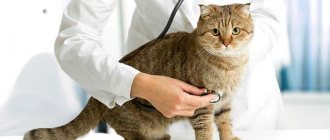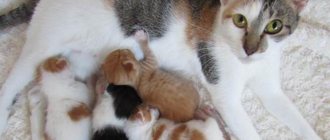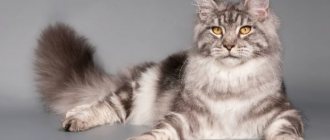10473Pavel
1
When deciding for the first time to start breeding Scottish Fold cats for commercial purposes or for themselves, the owner must know exactly everything about the birth of kittens. In most cases, the birth of a Scottish cat takes place without complications, and the four-legged mother only needs the support of the owner for a more comfortable birth of the kittens.
During pregnancy, a cat requires high-quality nutrition and careful monitoring of its condition. If the mating was the first and the Scottish female is still too young, she can give birth to only one kitten.
More mature cats that give birth more than once give birth to 5 to 7 kittens. The duration of labor in a normal course can last up to a day. Pregnancy lasts from 56 to 71 days, most often the birth of kittens occurs on the 65th day.
© shutterstock
Cat behavior before giving birth
Purebred Scottish women, as a rule, have a calm, balanced character, they are playful and friendly. Most owners note their extraordinary intelligence.
The onset of pregnancy changes the cat's usual behavior. In the early stages, she develops toxicosis, the animal may refuse to eat, but this does not last long.
Pregnancy is diagnosed 14 days after mating. After another 10 days, the expectant mother’s appetite normalizes, she gains weight well, tries to lie down more and more often, and plays little.
It has been observed that Scottish Fold cats are especially cautious when they experience the stress associated with bearing kittens and future births for the first time.
The care and nutrition of a pregnant Scot usually remains the same as before. But vitamin supplements during the period of bearing kittens are mandatory for the expectant mother. If your cat eats commercial food, replace it with a special mixture that is enriched with vitamins and microelements.
After 30 days of pregnancy in a cat:
- the nipples become enlarged and swollen, their color becomes pink-red;
- The stomach is noticeably rounded.
The cat's diet is increased by 50%. With a natural feeding method, it is necessary to ensure that the products contain a sufficient amount of protein.
Important! The owner should ensure that the cat gets daily (moderate) exercise, but at the same time it is important to ensure that it does not climb too high.
One of the problems facing pets who are expecting offspring is obesity. If you feed your Scottish Fold too much, it can cause big problems during birth, especially if the cat is pregnant for the first time. 2 weeks before the birth of the kittens, the Scottish mother begins to experience fluctuations in appetite again. She eats less, and this is considered normal.
You can tell that your cat is about to give birth by the following signs:
- anxiety: the cat walks around the house, chooses a place for the nest;
- increased licking of the abdomen and genitals;
- irritability;
- non-standard behavior.
About a week before the kittens are born, the pet begins to behave as if it is looking for something. She can rummage through linen, rummage in the closet or on the bed, and hide from her owners. So the Scottish woman is trying to find a cozy place for her future babies. The owner should prepare the nest himself.
A box or box 70–80 cm long with a large lid is suitable for this. Many cats do not like to be watched during labor. In order not to irritate the Scottish woman, the box is covered with a lid and periodically looked in to monitor the process.
You need to make a hole in the side wall of the temporary home for entry. The inside of the box is covered with a warm and clean cloth, under which an oilcloth is placed. The nest is placed in a quiet corner where there are no drafts. It is better to accustom your cat to it in advance to determine whether it likes the location of the home.
If not, you need to move the nest to the place that she herself chose.
Interesting! It is not difficult to understand that a Scottish cat will soon give birth: the animal is nervous, follows its owner, refuses to eat, and meows. If such signs are observed, it is time to prepare for the appearance of kittens (in the next 12 hours).
What care does your pet need during this period?
When a cat bears its offspring, it needs to be cared for competently. She moves much less. Nevertheless, you need to give her at least some physical activity. Otherwise, obesity is possible. Be sure to limit your cat's movement during the last weeks of pregnancy. Don't let it get too high. Since she has gained a lot of weight by this point, her center of gravity is shifting, so she can lose her balance and fall at any moment.
As a rule, a cat's diet does not change much during pregnancy. But if you gave her dry industrial food, it is better to choose for her a mixture intended for feeding kittens. It is rich in vitamins and mineral trace elements, so it is also suitable for the expectant mother. When the gestation period is 1 month, the pet needs to increase the amount of its diet by half.
Make sure that the foods your pet eats contain plenty of protein. About two weeks before giving birth, a Scottish woman's appetite worsens. Don't feed her too much as it is important to keep her from becoming obese. Otherwise, the process of giving birth to kittens may become more complicated.
Features of the first lambing
When a Scottish cat gives birth for the first time, she does not always understand her condition. The animal may experience panic. Such births, as a rule, are always more difficult than all subsequent ones. Complications often occur.
If a Scottish cat gives birth for the first time, she runs after her owner, meows and asks for help. You need to calm the animal, talk to it, stroke it, and take it to the prepared nest. Sometimes you have to do this several times as the expectant mother comes out of the box and starts running again.
It happens that a cat does not feed newborns or care for them. You shouldn’t be afraid of this behavior of the animal, it’s just that the necessary hormones have not yet been produced in the body. The babies need to be placed close to the nipples, and until the mother begins to lick them, sit next to the cat family.
Important! If the Scottish Fold's first pregnancy continues for 70 days, you should urgently consult a doctor.
Mating Scottish cats
The first heat in Scottish cats occurs before 9 months, but early matings are unacceptable, the mother herself may die or kittens with large defects will appear. The young cat’s body is not yet strong and is not ready for lambing. It is recommended to carry out the first mating of Scottish cats after she is 1.5 years old. When mating a Scottish Straight for the first time, certain rules should be followed:
- Breeders and veterinarians recommend allowing the first mating after she is 1.5 years old, when cats bear kittens.
- The applicant's cat is carefully selected; it must be strong, healthy, have the desired coat color and be quite active.
- Scottish folds (low-eared) are mated only with Scottish straights (straight-eared).
At what age should you breed?
The partner, who has reached 1.5 years of age during estrus, is brought together with a pre-selected male for the first mating. Scottish Straight cats can mate from the age of 10 months; from the moment of puberty there are no age restrictions for them. Cats become active in the spring; they behave restlessly, sometimes aggressively. They mark the area around with an unpleasant odor and invite their partner for mating. Scottish cats can mate with a cat and produce offspring on average until they are 7-8 years old and older.
To successfully complete mating and get kittens, you need to be well prepared:
- Both pets must be vaccinated, dewormed and healthy, which is noted in the animal passport
- Mating is always carried out on the cat's territory. Favorable conditions are created for the cat in another house. They maintain her usual diet and provide her with her own tray, with her own scent.
- To ensure the safety of mating, the animals' nails are cut the day before so that they do not scratch each other.
- Partners are given time to get used to each other and get to know each other.
- It is useless to force animals to mate; maybe one of them is not ready for mating for some reason.
Choosing a partner
For cats of the Scottish breed, especially for folds, choosing a partner is not an easy task, but it is an important task for obtaining future offspring. The breeder from the nursery where she was raised can help. You can learn information about breeding cats from local advertising and club publications, look at exhibition catalogues, and you can look at the GCCF stud books, where you can choose a breeding animal.
Scottish studs differ in mating conditions:
- Free cats who can mate with any partner.
- Limited breeding cats, specially kept for a limited circle of club animals.
- Cats are available only for mating with their own type of cat breed within the cattery.
Breeders specifically select and raise breeding cats, keep them in excellent physical shape, and monitor their health and the health of their partner. Do not allow excessive overload of the animal, regulate the number of matings. The period of breeding of cats lasts, as a rule, for 4–5 years, then they are castrated and kept as pets.
Before mating, it is advisable that the breeding cat and the mating partner have a certificate of veterinary examination of the animals.
For the first mating of a young cat, a mature, experienced sire is chosen. Such cats are more expensive, but more reliable, so that mating does not fail due to the animals themselves being unprepared for mating.
If the partners are incompatible, when the cat shows aggression when covering, bites, scratches, then the mating is refused.
For mating, the partner is brought to the cat’s territory, where his owner is responsible for her maintenance during the mating period.
How does mating work?
Mating of animals is a long process and takes place in several periods:
- Preparatory. When a partner is ready for mating, she is taken to the partner’s cat, by prior arrangement. The basket is placed in the place indicated by the breeder so that the cat can look around, get used to the smells, and sniff with the cat.
- The courtship period, which lasts from 3 to 4 days, depends on the temperament of the animals. If this is the female’s first mating, she behaves nervously; she is calmed down by stroking and caressing. If the animal shows aggression, cover it with a blanket until it calms down.
- The mating process takes place under the supervision of the breeder. Before this, the animals are not left alone unattended and, if necessary, are taken to different rooms.
To prevent the animals from slipping, a rug will be placed under their feet. The female gets into a comfortable position, moves her tail, and the panther jumps on her and grabs her by the scruff of the neck. The coating process takes a few minutes.
At the moment the mating is completed, the female screams, rolls around on the floor, and the cat is protected from the aggression of the partner. How to understand whether one mating is enough for mating, therefore, for reliability, the breeder can allow 1-2 more matings of animals. After the process is over, the partners clean themselves up and lick their genitals.
After finishing the covering, the animals are examined, and if there is a wound, they are treated with an antiseptic solution. The fertilization process can last up to 2 days.
Preparatory stage
The owner of a Scottish Fold should prepare in advance for childbirth at home. First of all, noise, strangers and drafts should be excluded.
It is better to replenish the first aid kit in advance:
- surgical gloves;
- Vaseline;
- nylon thread;
- iodine;
- hydrogen peroxide;
- sterile wipes;
- 1 and 2 ml syringes;
- oxytocin;
- traumeel, gamavit, glucose (5%), ascorbic acid in injections.
The owner should always have clean towels, a heating pad, small sterile scissors, and a microenema on hand. You need to communicate with your cat calmly, kindly, without sudden movements. If the expectant mother decides that something threatens her, she can delay the onset of labor and quickly make a new nest.
Breeding Scottish cats
It has been scientifically established by breeders that mating a Scottish Fold is permissible only with a straight-eared cat, also of the Scottish breed. Or, conversely, a straight-eared female with a fold-eared cat. Interbreeding is prohibited. This requirement is explained by the genetic peculiarity of lop-eared animals.
Violation of this mating rule can result in:
- miscarriage in early pregnancy;
- to the birth of non-viable fold-eared kittens;
- Scottish Fold kittens born will have problems in the musculoskeletal system.
How does a Scottish Fold cat give birth?
Long-haired Scottish females bear offspring from 63 to 75 days. The length of the term is influenced by the number of cubs. With a small pregnancy, the gestation period increases. If there are three or more kittens, there is a high probability of premature birth.
First period
As a rule, cats hide their unwellness, but during labor the pain is so severe that they forget about it, their excited appearance speaks for itself. Frequent breathing, dilated pupils, erratic movements, and groans indicate the onset of labor.
Important! If a cat begins to struggle, it loses control and may bite its owner.
The pain provokes the development of a panic state in a pregnant Scotswoman. But if the cat owner is experienced enough, he will calm his pet, help her cope with fear, and she will be able to give birth at home.
The first stage of labor sometimes lasts up to a day. Contractions of the uterus occur, and fluid is released from the cat’s genitals. As a rule, the cat walks around the house at this time and experiences severe pain. At the same time, she strains and tries to bite herself at the root of her tail.
Gradually, the kittens in her stomach move towards the opening of the birth canal.
Second period
When a cat's birth canal is fully dilated, a gray-red fluid comes out of the vagina. The Scottish one lies down in the nest, begins to push even harder, and meows. After some time, the kittens pass through the birth canal and are born.
Each fetus is contained within a water bladder (amnion). It is necessary to preserve this shell until the kitten is born, otherwise it may die. It is considered correct when the animal appears head first. But sometimes the hind legs come out first, and then the muscles of the uterus contract and prevent the baby from coming out. In this situation, you need to help the cat relax its muscles: take it by the scruff of the neck and gently place it on its paws. The animal's attention will switch to the withers, and the cat will unclench its vagina.
If the attempt is unsuccessful, you should grab the cub's skin through a napkin and gently pull the kitten out with rocking movements. In this case, it is necessary to make an effort while pushing, but do not grab the animal by the paws or tail. Kittens are born one after another, but sometimes there are long pauses during which the cat licks the already born babies. After a short rest, the Scottish Fold continues to give birth.
After each cub is born, the mother bites through the amnion, bites off the umbilical cord, and licks the kitten to clean the baby's mouth and nose. If she doesn't do this, the newborn will suffocate.
To deliver a cat at home, the owner of the Scottish Fold must be prepared to independently cut the amnion with scissors and clean the kittens' respiratory system with a microenema if the mother has not licked them. As a result, the cubs will squeak, but there should be no wheezing or gurgling.
The umbilical cord of newborns is cut when they are already breathing on their own. Sterile scissors or a knife should be used. After 3 days, the umbilical cord dries up and falls off.
Babies should be immediately massaged through damp gauze to stimulate blood circulation, as well as perform natural needs. Then the kittens are placed next to their mother, and before that they are blotted with a clean towel. If the cat is still giving birth, the babies are placed on a heating pad. After 3–5 hours, all the offspring are born.
Important! The time interval between the birth of cubs is from 10 minutes. up to half an hour.
Third period
Pauses in the labor of the Scottish Fold sometimes last for several hours. You can understand that the cat is giving birth again by renewed attempts. If the animal calmly overcomes natural difficulties, there is no need to worry. But if the mother’s health worsens, she must call the doctor for a consultation or a home visit.
After each cub, an afterbirth appears. Sometimes the young mother eats it. Such food is beneficial for her body and helps increase lactation. But the owner of the Scottish woman must ensure that she does not eat more than 2 afterbirths (this negatively affects the digestion of the woman in labor).
Interesting! It happens that a young mother eats a kitten if it is too weak. In this way, nature regulates the survival of the strongest individuals.
If the cat has stopped giving birth, and the number of afterbirths corresponds to the number of cubs, we can consider that the process is completed and there is no longer a need to accept kittens. After this, it is advisable for the pet to receive an injection of oxytocin (0.3 ml) to strengthen uterine contractions for cleaning and increase milk production.
Preparing for childbirth
A cat's pregnancy lasts 63-65 days. It happens that labor begins 70 days after conception.
If the expectant mother feels well, eats normally, has no digestive problems, and the kittens in her stomach move as usual, then there is no reason to panic, leave the kitten alone until the 70th day.
What needs to be done to ensure that a cat gives birth at home successfully?
Organize a maternity place
Prepare a strong cardboard box measuring (l/w/h) 50/50/30 cm.
It should have a removable “roof” so that you can help the kittens emerge and then do a little cleaning there.
The box must be placed in a place where there are no drafts or noise.
The owner’s task is to organize a convenient maternity place for the cat, where the mother and kittens will be comfortable and safe.
Some install a heating pad under the bottom of the “nest”, others place an infrared lamp above it - this is not important, it is important that the following temperature regime is maintained in the box:
- first week after birth – 29 C
- second – 26 C
- third – 23 C
- fourth and subsequent – 21 C
It is also necessary to leave a place where there is no heating so that the cat can lie down there if it gets hot.
Take care of the hygiene and safety of the maternity area
You should not place soft and thin fabric on the bottom; blind babies can become entangled and suffocate in its folds.
Let it be several layers of newspapers or clean soft paper. Moreover, before giving birth, a cat, following instinct, will want to rummage around and arrange its “nest.”
Introduce the cat to the birthing area in advance. If she refuses to live in it, give her the opportunity to produce offspring in a place of her choice, and then move the mother and children to prepared conditions
Make sure the box does not have any irritating odors. Otherwise, the cat will simply refuse to give birth and raise babies in it.
The entrance to the box should be located at the cat's chest level, which is approximately 10 cm from the floor.
This way it will be better protected from drafts, and the kittens won’t be able to accidentally crawl out.
Introduce the cat to the box in advance. If she refuses to live in it, give her the opportunity to produce offspring in a place of her choice, and then move the mother and her children to prepared conditions.
Keep everything you need for childbirth at hand, because the process can begin at any time
Gather the necessary “equipment”
- Cotton fabric
- Cotton pads
- Waterproof diapers
- Sharp scissors (wipe them with alcohol before delivery)
- Umbilical cord string
- Hydrogen peroxide and iodine
- Disposable syringes, preferably insulin, and oxytocin
- Small rubber bulb
12-24 hours before labor begins, the cat’s body temperature drops to 37°C, maybe even lower; and after its maximum drop, a day later the cat begins to give birth
Possible complications
Childbirth does not always go flawlessly. Unforeseen and not very pleasant consequences may develop.
The cat cannot give birth to her first kitten
It happens that at the beginning of labor a problem arises with the very first baby. Perhaps the fetus is large, or its location is not normal. When the process has been going on for an hour, and the cat cannot give birth, it is necessary to urgently call a doctor.
If the baby gets stuck, the mother in labor will need help. In this situation, the cat owner must:
- Take Vaseline oil into a pipette and lubricate the birth canal.
- When the presenting part of the kitten appears, immediately press on the part of the perineum located below the anus.
- Grab the animal by the skin in the withers area (through a sterile cloth) and, while the cat is pushing, slightly pull it towards you.
It is better to immediately place the successfully extracted animal in the mother's body; she will do the rest herself. If the Scottish cat does not lick the newborn, he needs to be wiped with a damp cloth, his nose and mouth should be freed of mucous masses using a small enema and placed back with the cat.
Dead kittens
If the newborn is not breathing, you can try to bring him back to life. The cat owner will have no more than 5 minutes to do this. If during this time the animal does not give a voice, further resuscitation will be useless.
The sequence of actions is as follows:
- Gently hold the baby's head between your fingers;
- start shaking back and forth (like “chopping wood”), after every 3-4 shakes, rub the kitten’s chest, blow into the nose;
- Place the squealing baby next to the mother.
If the baby does not come to life, you can apply cotton wool with ammonia to his nose. The most radical way is to dip the kitten alternately in warm and cool water. This stimulates the heartbeat. The revived baby's nose and tongue turn pink.
It happens that a cat does not want to lick a child who has already been in the wrong hands. In this case, you need to take a piece of damp gauze, massage the baby's anorectal area to induce bowel movements, and place the baby again next to the cat.
The placenta did not come out
If after the birth the cat is in a nervous, restless state, there may be some placenta left inside. This can lead to the development of inflammatory processes and intoxication.
You should call a veterinarian as soon as possible. No animal owner can cope with this problem on their own.
Prolonged labor
If all the signs of the first stage of labor are observed, the animal is suffering, but does not give birth, despite strong attempts, the help of a doctor will be needed. The cat should be taken to the clinic as soon as possible and x-rayed.
Signs of prolonged labor are:
- absence of kittens 1–2 hours after the start of the process during strong contractions;
- the appearance of sudden weakness in a cat against a background of elevated temperature (40°C or more).
If bleeding starts and does not stop within 5–8 minutes, you should urgently call a doctor. The best option would be to transport the cat to a veterinary clinic.
Caring for a pregnant cat
Scottish cats themselves take precautionary steps during pregnancy, lead a sedentary lifestyle, and are extremely neat and clean. The owner needs to help the cat during this period, follow simple rules:
- Transfer to extra-premium food from specially developed lines for pregnant and lactating cats.
- It is strictly forbidden to treat Scots with medications without the recommendation of a veterinarian.
- Do not palpate the cat yourself; you may harm the embryos. A specialist uses an ultrasound to determine the gestational age, the number of embryos, and the approximate day of birth.
- Street walks are prohibited to prevent the pet from becoming infected with infectious diseases. Ventilate the room more often, but protect the tartan from drafts.
Attention! Protect your cat from stressful situations, moving, changing personal hygiene items and food, loud noise and music, so as not to frighten the pregnant mother or provoke miscarriages.
Nutrition
The cat’s diet does not change, only the volumes and quantities are adjusted, minerals, vitamins, and a lot of protein are added.
- after 3 weeks, the increased portion of food is divided into 4 doses;
- by the middle of pregnancy, they gradually double the daily portion of food, but do not make the cat become obese, which can complicate childbirth;
- in the final stage before childbirth, they return to the normal diet that they had before pregnancy.
After giving birth, the cat needs simple food that is digestible by the body. The cat is fed up to 5 times a day, fish oil, calcium and phosphorus supplements are added to the food, and milk and fermented milk products are given.
Important! Mother and kittens should have constant access to fresh, bottled water.
Postpartum period
The day after birth, the cat should be examined by a doctor. He will check the Scots belly (if there is any placenta or cubs left there) and measure the temperature. If the readings are elevated (from 39°C), treatment will be required.
Minor reddish or greenish discharge is considered normal for a cat that has recently given birth. They may appear within the first 20 days after birth. But if pus appears in the liquid, it is better to show the animal to a doctor.
During the first week after giving birth, your Scottish Fold cat needs to have its temperature measured daily. You can take her out for walks, but under strict control. The cat may come into heat again, and then mating will lead to another pregnancy, which is undesirable for a weakened animal.
A nursing mother must be provided with adequate nutrition. Food should be rich in proteins, microelements, proteins and fats. There are special formulations for nursing cats on the market. They are saturated with all the necessary substances for kittens and the mother herself. The volume of portions, compared to the usual amount of food, is tripled.
Scottish fold cats belong to a special category of animals - they were bred artificially, so they are especially vulnerable during childbirth. They need proper care and timely support.
If the animal is healthy and preparations for the birth of babies are carried out correctly, beautiful and strong kittens will appear. However, it’s a good idea to have your veterinarian’s number on hand just in case.
Childbirth process
After the start of contractions in a kitty, after a certain time, a mucous plug comes out of the vagina.
Before you give birth to a cat, close the door to the room - the animal may run out of fright, do not expect special consciousness from the woman in labor.
The most difficult thing is the birth of the first kitten, then the process becomes easier.
Kittens appear in bubbles that the mother must chew.
Following the blisters on the umbilical cord there is usually an afterbirth (which looks like a piece of liver), which the cat eats - don’t stop this!
The afterbirth contains a hormone that stimulates labor and milk production.
However, do not eat too many afterbirths, 3 are enough, otherwise the mother and her babies may have an upset stomach.
You might think that a cat would cope with childbirth on her own, but the role of the owner in the process of giving birth to a cat is difficult to overestimate. You must be nearby at all times and provide assistance at any time.
What you need to have on hand to help
A non-specialist is unlikely to be able to accurately determine whether in a given specific situation the help of a specialist is needed or whether independent participation will be sufficient. But if it is definitely decided to control the birth without a veterinarian, then the list of available materials should be as follows:
- surgical gloves (disposable or sterile) – 2-3 pairs;
- moisture-absorbing medical diapers (unscented) – 4-6 pieces, depending on size;
- a small waffle towel (clean, intensively ironed) - may be needed for resuscitation of a weak newborn baby;
- gauze or bandage wipes (sterile) – up to 2 packs;
- good cutting blunt scissors;
- surgical silk, catgut or any other surgical thread for tying the umbilical cord - sterile initially or soaked in alcohol on the eve of the expected birth;
- a small rubber bulb (syringe) – for pumping out mucus from the kitten’s airways;
- sterile petroleum jelly;
- hydrogen peroxide 3%, betadine or brilliant green solution;
- ammonia;
- a heating pad or electric sheet if the room is cool.
We recommend reading: Preparing for travel
Only after consultation with a veterinarian (!) the following are added to the list:
- oxytocin;
- lauritin;
- calcium gluconate;
- disposable syringes - insulin and regular, 2 ml volume.
In general, consultation with a veterinarian is required! If a decision has been made to perform obstetric care on your own, then there must be a clear understanding of what is needed, why, and when the use of this or that material/drug will be appropriate.
How to deliver a cat
The most important thing in helping a cat is a positive attitude and lack of panic. Childbirth, although a natural process, is important to control it to the maximum. Especially if the cat is purebred. For example, in British and Scottish cats, births rarely occur naturally over the last 2-3 years. Increasingly, these breeds are being delivered by caesarean section. This is due to the structural features of the pelvis and the absence of contractions.
At the stage of contractions and pushing
How to remove fleas from a cat at home
With a natural birth, the kitten comes out in 1-2 contractions. You can pull the kitten lightly and very carefully, but only when the cat is in a fight. To understand when a contraction is occurring, you should place your other hand on the cat’s stomach and try to feel when it tenses.
However, it is better not to interfere with the cat again.
Important! If more than two hours have passed since the start of contractions, and the cat still cannot give birth to her first kitten, this is a reason to contact the veterinarian and immediately go to the clinic. If the head or hind legs and pelvis have already been born, and then there is a pause of more than 20 minutes, you should also contact your doctor.











